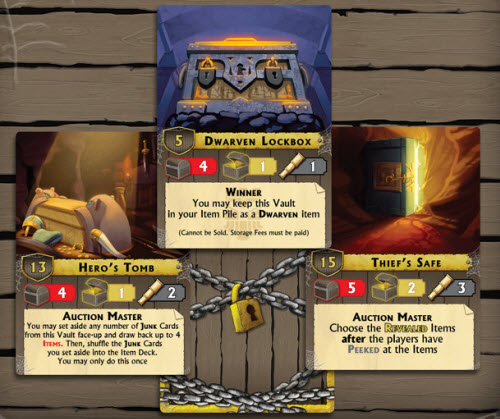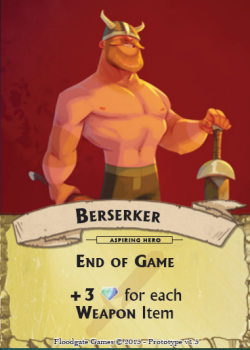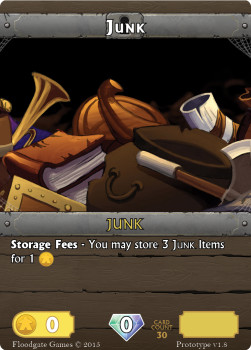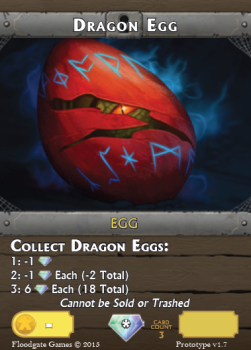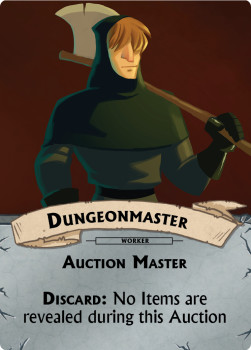Thirteen, we have thirteen. Do I hear fourteen? Anywhere? Fourteen to the tall gentleman in the back! Fifteen, fifteen? Fourteen going once – fifteen to the gnome down in front! Sorry m’am, didn’t see you there. Now that we have fifteen, how about sixteen? Sixteen is the bid for the treasures within. Could be jewels, magic items, who knows? All we know is that this warrior won’t be coming back for it. Fifteen is the bid, do I hear sixteen – sixteen to the dwarf with an axe to grind. I don’t mean that in a bad way sir, just that your axe is looking a little dull. Seventeen, who wants seventeen…
Check your coat at the door and grab your bidding paddle, we’re entering another exciting rendition of Vault Wars! In this exercise of liquidation, 3-5 players have been invited to bid on dormant storage lockers left behind by daring adventurers. These vault owners haven’t paid their dues in quite some time, either because they’ve wandered off, forgotten about their loot, or met their glorious end in battle. In any case, it’s time to empty these things out. That’s where you come in.
Vault Wars is predominately an auction game of bidding and bluffing, with each player taking turns being the crafty Auction Master in cracking open a vault and bidding on the contents. What lies inside is sort of a metaphor about the game itself. That is, the concept is simple, but it’ll take a little practice to maximize your yields.
At the beginning of Vault Wars, you are dealt a handful of Vault cards, the number of which depends on player size. Cards like these:
To start Vault Wars, players draft these vaults (think 7 Wonders) by choosing the most appealing to their adventuring palette and passing the remaining ones. This minor but pivotal aspect of the game ensures that when your turn comes around to be the Auction Master you have slight say over what and when you want to put things up for sale.
At the beginning of a round, players choose and simultaneously reveal one of their vaults, establishing turn order by comparing the vault’s initiative values.

“Vault 4, down the hall to the left.”
On your turn, you empty out your vault. Vault Wars works on the normal auction practice of there being an opening bid, people raise each other, and then someone wins, just like the…let’s call it ‘show’… that it’s loosely inspired by. However, when you wander into a Gringotts-style setting like this one, be prepared for the unconventional. Every vault in Vault Wars alters the auction in some way, keeping things inventive and helping the game avoid becoming overly repetitive.
As the Auction Master, you draw cards from the Item deck equal to the amount listed on the Vault card. These become the vault’s contents. The Item deck contains a whole variety of possibilities, from valuable gems, to powerful weapons and suits of armor, to useful artifacts that can be used to your advantage. Just like a real storage locker, though there’s also going to be a lot of junk thrown in there too.
Next, you must choose and reveal the stated number of Item cards, giving everyone some idea of what may be in that vault. Then, the remaining Item cards are passed around to each player, with each getting to randomly peek at some of them. This means not everyone is going to have the same amount of information about the contents, creating an interesting twist on the bidding process.
Now that you’ve potentially seen a couple gems (perhaps literally), it’s time to bid. Everyone starts with 20 gold, because honestly, if you walk into an auction with no money, you have to question why you’re going in the first place.
When bidding, you are doing so for you own advantage, as you can gather the necessary items to become renowned adventurer yourself. Potentially on the cheap. To that end, Vault Wars provides you with two secret Aspiring Hero cards at the beginning of the game that will provide you bonus points for getting things they want.
Bidding is simple: the Auction Master states the opening bid. After that, they are no longer allowed to participate in the auction. Everyone else then passes or raises. In Vault Wars though, unlike many bidding games, you are free to pass one time around the table and jump back in after if you so choose. This can make the flow a little less organized at times when cycling through bids, but it’s also a bit more realistic. When everyone passes, the high bidder wins the contents of the vault. If the Auction Master wins their own auction, the bank gets the money. Otherwise, the money goes to the player whose vault it was.
This is really where the beauty of Vault Wars lies. The game deviates from a standard bidding process by playing around with the idea of both limited information and bluffing. This gets at the heart of the game’s appeal; for a small game, it has a pretty big psychological component to it. Players have to contend with bidding on vaults whose contents they don’t fully know, and the bids of other players are their only cues.
It’s entirely possible that a high bid means the Auction Master or another player really likes what they saw. However, it’s also just as likely that they’re simply trying to get other players to shell out money on nothing. Moreover, does the Auction Master reveal good items and hope for a bidding war, or do they only show junk in the hopes of keeping a hidden treasure for themselves?
Hey, this is called Vault Wars for a reason. You want items and money, and you want your opposition to be lacking in both.
While this aspect of the game is largely successful, there are are a couple small caveats to make note of. First, although this is a 3-5 player game, Vault Wars works best with a full table. Three is slightly lackluster as you can only have two people trying to outbid one another at any given time. Second, much like that first time you stepped into a thrift store, it can take a little practice with Vault Wars to learn which items are worth going after. It’s possible for your first game or two to go poorly, but experience remedies that. Since it’s only a half hour(ish) game, that’ll happen pretty quickly.
After every player cleans out their Vault for the turn, players do some general tiding up. All Items can be held on to for VP at the end of the game or sold for their gold value for some needed cash, and players who are still low on funding can visit Vinnie the Loan Shark for some quick gold in exchange for negative VP. In addition, certain Items are Artifacts that you can place in your tableau, providing special abilities. In exchange for equipping these Artifacts, however, they no longer count for VP.
Lastly, everyone has to pay for their own item storage. Think about it: if you just picked up a giant suit of armor, you have to put it somewhere. For each non-equipped Item you keep, you have to pay 1 gold.
Rounds continue until all of the vaults are all cleaned out. Then, you see how you cleaned up by totaling the VP of stored items plus any bonuses from one of your two Aspiring Hero cards. The person with the most VP is the winner of this episode of Vault Wars!
But wait, like a hidden cache of baseball cards in a shoebox in the corner, there’s more!
To add to this cutthroat bidding game, Vault Wars offers up an additional bit of complexity in the form of Worker cards. Workers are optional and will be offered as a campaign stretch goal, but they do add additional variety into the game with little added complexity. If anything, they can sometimes feel underutilized.
Each round, after initiative has been set, players may purchase one of six Worker cards – for a cost. Each card has a useful one-shot effect, but their usefulness is rather situational, so you’ll have to decide if they are worth spending a bit of your precious auction money on them.
Although we can’t guarantee that the contents of every auction will make you rich (and if we did, we’re pretty sure we’d use that information ourselves), for those who enjoy auction mechanics, Vault Wars is one safe bet. Vault Wars challenges players to interact, with everyone possessing different amounts of hidden information, and yet it isn’t a deduction game. It also encourages players to bluff and deceive their competition, and yet it isn’t a game about lying. Instead, Vault Wars weaves seemingly disparate mechanics together in a way that’s both psychologically and mechanically engaging.
It may take a couple times through to find your swindling stride, but when that happens, it becomes a fun half hour exercise in seeing how much money you can make off someone else’s hard earned abandoned treasures. If this sounds like something to put your money down on, then check out Vault Wars over on Kickstarter before it’s going, going, gone!
[sc:Preview-Sealer ]
Photo Credits: Vault Wars cover and images by Floodgate Games; Gringotts by Warner Bros..

